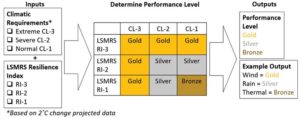A framework for climate resilient performance standard of commercial roofs
Determination of roofing resilience index

Once a climate load is determined, the building designer must then select a roofing resilience index. Figure 6 outlines the definitions of resilience index for the low-slope membrane roofs (LSMR). A roof designed to the minimum requirements specified in building codes (NBC and/or NECB) falls under the resilience index of one. Roofs designed to withstand emergencies and the harshest climates have a resilience index of three, and systems with a resilience index of two fall between minimum and maximum required design specifications. While the climate load is dictated by the building location, the level of the resilience index is selected by the roof designer.
After the climate load is determined and the resilience index is selected, a performance level requirement is generated, as shown in Figure 7. Performance levels are gold (highest), silver (intermediate), and bronze (minimal). For any LSMR design, performance levels can be different for wind, rain, and thermal load, as demonstrated in the example box of Figure 7.

The example output box shown in Figure 7 requires a performance level of gold for wind, silver for rain, and bronze for thermal protection. Only NBC and NECB requirements need to be addressed to meet the bronze requirements for thermal performance. To meet the gold-wind and silver-rain performance requirements, additional specifications from CSA A123.26 must be fulfilled. Figure 8 shows a summary of which clauses pertain to each performance level and requirement.
For the above LSMR design example, clauses 6.1.1 to 6.3.3 from Figure 8 must be met to satisfy the wind performance requirements; and clauses 7.1.7 to 7.1.3 and 7.2.1 to 7.2.6 must be fulfilled to satisfy the rain performance requirements. To show an example of what these clauses entail, clause 6.1.8 for gold level wind-roof performance specifies:
A “peel-stop” bar should be placed over the roof membrane near the edge flashing/coping to provide secondary protection against membrane lifting and peeling, as shown in Figure 9. The bar has to be anchored to the parapet or deck. The spacing is recommended between 102 to 305 mm (4 to 12 in.) on centre. Between each bar a space of a few inches should be left and the bar should be stripped over with a stripping ply.
Similarly, for the design to meet silver (and gold) rainwater resistance performance requirements, clause 7.2.1 specifies:
The designed drainage roof slope shall be a minimum of two per cent.
To summarize, the climate load is determined based on a building’s location, and the resilience index is selected by the designer. These are used together to determine the performance level of a roof. If a performance level of bronze is required, only the relevant NBC and NECB specifications need to be considered. If a silver or gold performance level is required, extra specifications from CSA A123.26 are required.
The specified slider does not exist.
Updating the wind roof calculator on internet tool
NRC currently hosts a freely available Wind Roof Calculator on Internet (RCI) tool that calculates wind loads on roofs based on NBC 2015 as well as various details about the building’s location and applications. WIND-RCI is widely used by the roofing community for wind load design of LSMR. This existing tool is now being updated such that it will facilitate the designer to streamline the process of selecting a performance level. In addition to the tool’s existing capabilities it will also identify the appropriate severity classes (normal/severe/extreme) based on the city and province, and it will allow designers to select the resiliency index they deem appropriate. The tool will then determine the necessary gold, silver, or bronze performance levels for wind, rain, and thermal conditions.
![]() Abhishek Gaur, PhD, is a research officer with the Construction Research Centre of the National Research Council Canada (NRC). At NRC, he is responsible for providing climate data needed to more effectively test and design climate resilient building systems and for facilitating climate data access to building practitioners by developing effective user-interactive tools. He obtained his masters and PhD degrees from Western University. Gaur can be reached at abhishek.gaur@nrc-cnrc.gc.ca.
Abhishek Gaur, PhD, is a research officer with the Construction Research Centre of the National Research Council Canada (NRC). At NRC, he is responsible for providing climate data needed to more effectively test and design climate resilient building systems and for facilitating climate data access to building practitioners by developing effective user-interactive tools. He obtained his masters and PhD degrees from Western University. Gaur can be reached at abhishek.gaur@nrc-cnrc.gc.ca.
 Flonja Shyti, EIT, is a civil engineer in training who received her degree from the University of Ottawa. She works in the roofing and insulation group in the Construction Research Centre at NRC. She helps characterize building material properties and determine wind loads based on the National Building Code (NBC) and the American Society of Civil Engineers (ASCE) 7, Minimum Design Loads and Associated Criteria for Buildings and Other Structures. Shyti can be reached at flonja.shyti@nrc-cnrc.gc.ca.
Flonja Shyti, EIT, is a civil engineer in training who received her degree from the University of Ottawa. She works in the roofing and insulation group in the Construction Research Centre at NRC. She helps characterize building material properties and determine wind loads based on the National Building Code (NBC) and the American Society of Civil Engineers (ASCE) 7, Minimum Design Loads and Associated Criteria for Buildings and Other Structures. Shyti can be reached at flonja.shyti@nrc-cnrc.gc.ca.
 Bas A. Baskaran, PhD, P.Eng., is a group leader at NRC, where he researches the performance of roofing systems and insulation. He is an adjunct professor at the University of Ottawa, and a member of Roofing Committee on Weather Issues (RICOWI), RCI Inc., Single Ply Roofing Industry (SPRI), and several other technical committees. Baskaran is a research advisor to various task groups of the National Building Code of Canada (NBC). He was recognized by Her Majesty Queen Elizabeth II with a Diamond Jubilee medal for his contribution to fellow Canadians. Baskaran can be reached at bas.baskaran@nrc-cnrc.gc.ca.
Bas A. Baskaran, PhD, P.Eng., is a group leader at NRC, where he researches the performance of roofing systems and insulation. He is an adjunct professor at the University of Ottawa, and a member of Roofing Committee on Weather Issues (RICOWI), RCI Inc., Single Ply Roofing Industry (SPRI), and several other technical committees. Baskaran is a research advisor to various task groups of the National Building Code of Canada (NBC). He was recognized by Her Majesty Queen Elizabeth II with a Diamond Jubilee medal for his contribution to fellow Canadians. Baskaran can be reached at bas.baskaran@nrc-cnrc.gc.ca.


